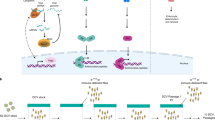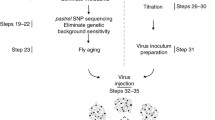Drosophila melanogaster can be parasitized by a picornavirus, the Drosophila C virus (DCV). The virus is not hereditary, but it is horizontally transmitted (by ingestion or contact). When first larval instars come into contact with DCV unusual interactions are observed between host and microparasite. DCV acts differently depending on the stage in the host's life cycle. It boosts the reproductive capacity of adults, but it diminishes survival during the pre-reproductive period. In infected flies, the DCV target organs are principally the follicular cells and the fat body. The infected cells resemble DCV-free cells. According to the parameters of the Drosophila lifecycle, measured for different Drosophila strains, at different temperatures, and for different viral doses, DCV could be considered either as a parasite, because it increases pre-adult mortality, or as a mutualist, because it increases the reproductive capacity of the host and decreases its developmental time. Like many viruses, DCV is extremely pathogenic when injected into flies, which then die within a few days. Only one strain resists the disease longer. The resistant phenotype is dominant. Genes of chromosome 3 of the host are involved. Interactions are discussed in terms of an ‘arms race’ and ‘peaceful cohabitation’. They are also considered in terms of biodiversity for the host and for the microparasite.
Similar content being viewed by others
References
Anderson R.M. and May R.M. (1979) Population biology of infectious disease. Part I: Nature 280. 361–7.
Bouma J.E. and Lenski R.E. (1988) Evolution of a bacteria/plasmid association. Nature 335. 351–2.
Brun G. and Plus N. (1980) The viruses of Drosophila. In The Genetics and Biology of Drosophila, 2nd edn (M. Asburner and T.R.F. Wright, eds) pp. 625–702. London, New York: Academic Press.
Carton Y. (1984) Analyse expérimentale de trois niveaux d'interactions entre Drosophila melanogaster et le parasie Leptopilina boulardi (sympatrie, allopatrie, xénopatrie). Génét. Sél. Evol. 16, 417–30.
Contamine, D., Dezelee, S. and Wyers, F. (1989) Persistent infection by viruses. In Endocytobiology IV. (P. Nardon, V. Gianinazzi-Pearson, A-M Grenier, L. Margulis and D.C. Smith, eds). INRA Service des publications, pp. 425–7.
David J. and Fouillet P. (1971) Le taux intrinsèque d'accroissement naturel chez Drosophila melanogaster: intêret de ce paramète pour les études de dynamique des populations. La Terre et la Vie 118, 378–94.
Day P.R. (1974) Genetics of Host Parasite Interaction. San Francisco: Freeman.
Dru Ph., Bras F., Dezelee S., Gay P., Petitjean A-M., Pierre-Deneubourg A., Tenninges D. and Contamine D. (1993) Unusual variability of the Drosophila melanogaster ref(2)P protein which controls the multiplication of sigma rhabdovirus. Genetics 133, 943–54.
Fenner F. (1983) Biological control, as exemplified by smallpox eradication and myxomatosis. Proc. Roy. Soc. London 218, 259–85.
Fleuriet A. (1972) Répartition et fréquence du virus sigma dans des populations naturelles et expérimentales de Drosophila melanogaster. C. R. Séanc. Soc. Biol. 166, 598–601.
Futuyma D.J. (1979) Evolutionary Biology, Sunderland, MA: Sinauer Associates.
Gay P. (1978) Les gènes de la Drosophile qui interviennent dans la multiplication du virus sigma. Mol. Gen. Genet. 159, 269–83.
Gomariz-Zilber E. and Thomas-Orillard M. (1993) Drosophila C virus and Drosophila hosts: a good association in various environments. J. Evol. Biol. 6, 677–89.
Gomariz-Zilber E., Poras M. and Thomas-Orillard M. (1995) Drosophila C virus; Experimental study of infectious yields and underlying pathology in Drosophila laboratory populations. J. Invert. Pathol. 65, 243–7.
Jousset F-X. (1976) Etude expérimentale du spectre d'hôtes du virus C de Drosophila melanogaster chez quelques diptères et lépidoptères. Ann. Microbiol. 127, 529–44.
Jousset F-X and Plus N. (1975) Etude de la transmission horizontale et verticale des picornavirus de Drosophila melanogaster et de Drosophila immigrans. Ann. Microbiol. 126B, 231–49.
Jousset F-X., Plus N. Croizier G. and Thomas M. (1972) Existence chez Drosophila de deux groupes de Picornavirus de propriétés sérologiques et biologiques différentes. C. R. Acad. Sci. 275, 3043–6.
Jousset F-X, Bergoin M. and Revet B. (1977) Characterization of the Drosophila C virus. J. Gen. Virol. 34, 269–85.
Lautié-Harivel N. and Thomas-Orillar M. (1990) Location of Drosophila C virus target organs in Drosophila host population by an immunofluorescent technic. Biol. Cell. 69, 35–9.
L'Héritier P. (1970) Drosophila viruses and their role as evolutionary factors. In Evolutionary Biology (T. Dobzhanski, M.K. Hecht and W.C. Steere, eds) 4, pp. 185–210. New York: Appleton-Century-Crofts.
May R.M. and Anderson R.M. (1983) Epidemiology and genetics in the coevolution of parasites and hosts. Proc. Roy. Soc. London, B 219, 281–313.
Michalakis Y., Olivieri I., Renaud F. and Raymond M. (1992) Pleiotropic action of parasites: how to be goof for the host. Trends Ecol. Evol. 7, 59–62.
Moore N.F., Pullin J.S.K., Crump W.A.L. and Plus N. (1982) The proteins expressed by different isolates of Drosophila C virus. Arch. Virol. 74, 21–30.
Oldstone M.B.A. (1987) Molecular mimicry and autoimmune disease. Cell 50, 819–20.
Person C. (1959) Gene-for-gene relationships in host-parasite system. Can. J. Bot. 37, 1101–30.
Thomas-Orillard M. (1975) Tentative de localisation des gènes qui président au déterminisme du nombre d'ovarioles chez la drosophile. Archiv für Genetik 48, 116–27.
Thomas-Orillard M. (1984) Modifications of mean ovariole number, fresh weight of adult females and developmental time in Drosophila melanogaster induced by Drosophila C virus. Genetics 107, 635–44.
Thomas-Orillard M. (1988) Interaction between a picornavirus and a wild population of Drosophila melanogaster. Oecologia 75, 516–20.
Thomas-Orillard M. (1990) Paradoxical influence of an RNA virus on Drosophila host population. Endocyt. Cell Res. 7, 97–104. Virus Cole de la Drosophile et dynamique d'une population hôle.
Thomas-Orillard, M. and Legendre, S. Virus C de la Drosophile et dynamique d'une population hôle. (submitted).
Thomas-Orillard M., Jeune B. and Cusset G. (1995) Drosophila-host genetic control of susceptibility to Drosophila C virus Genetics 140, 1289–95.
Wildy P. (1971) Classification and nomenclature of viruses. In Monographs in Virology, Volume 5 (J.L. Melnick, ed.), pp. 81, Basel: Karger.
Author information
Authors and Affiliations
Rights and permissions
About this article
Cite this article
Thomas-Orillard, M. A virus-Drosophila association: the first steps towards co-evolution?. Biodivers Conserv 5, 1015–1021 (1996). https://doi.org/10.1007/BF00054418
Received:
Revised:
Accepted:
Issue Date:
DOI: https://doi.org/10.1007/BF00054418




